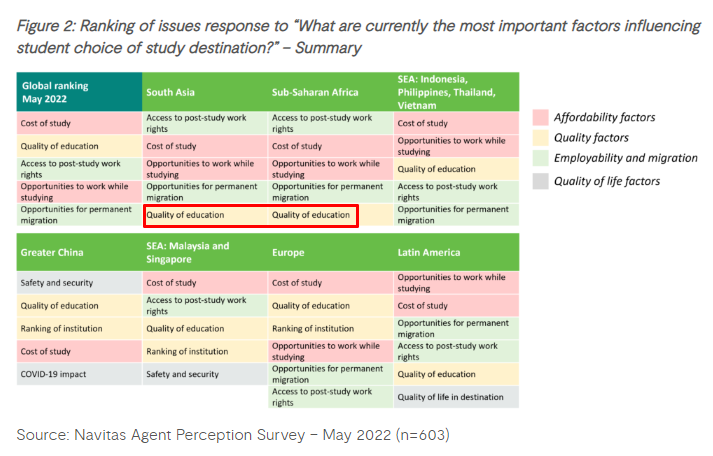A new survey of education agents by education company Navitas found that the top five factors influencing student choice of study destination globally are: cost of study, quality of education, access to post-study work rights, opportunities to work while studying, and opportunities for permanent migration.
However, for students from South Asia and Sub-Saharan Africa, they are most concerned with gaining post-study work rights, and are the least concerned about the quality of education:

Students from South Asia and Sub-Saharan Africa care more about work rights than quality of education.
These results should be no surprise. A recent study by IDP Connect revealed how the prime motivation for Indian students to study in Australia is to gain permanent residency and work rights:
IDP Connect’s New Horizons research shows international students consider migration incentives and employment opportunities when choosing where, what and how to study. “We’ve seen a significant decrease in interest from Indian students looking to study in Australia,” said Wharton, who said a key motivation for Indian students’ decision to study abroad include migration and face-to-face learning opportunities…
Wharton said if Australia can communicate a roadmap towards a large-scale return of international students, with clear pathways towards employment and migration outcomes, Australia could be in a good position to retain its status as a leading study abroad destination…
The former vice-chancellor of Macquarie University, Professor Steven Schwartz, also admitted that many international students only study in Australia to gain working rights and permanent residency:
[Professor Schwartz] said foreign students flock to courses likely to lead to jobs and permanent residency…
“Permanent residency is one of the main motivations to study in Australia’…
“If suddenly permanent residency was given to people who study poetry, it’s likely they’d all be doing poetry.”
New Delhi-based education consultant Gauravdeep Bumra noted similar:
“Most Indian students choose to study abroad, often at the cost of thousands of dollars, because they have a long-term goal of getting permanent residency, be it in Australia, Canada or the UK”.
“The day they open their borders, the student intake numbers will uptick…”
As has The Australian’s international education correspondent, Tim Dodd:
“Too many of the expanding numbers of students from India and the sub continent were in low quality, generic business courses, and hoping for permanent residency without having in-demand skills”.
Thus, any move to lift international student numbers will necessarily require Australia to reach further down the quality barrel and erode entry standards even further. Doing so would be detrimental for the long-run productivity and prosperity of Australia, which relies upon quality education and skills.
Instead of lowering the quality bar even further to boost numbers, Australia’s international education system should instead target a smaller intake of high quality students via:
- Lifting entry standards (particularly English-language proficiency);
- Lifting financial requirements needed to enter Australia; and
- Removing the link between studying, work rights and permanent residency.
These reforms would raise student quality, would lift genuine export revenues per student, would lift wage growth by removing competition in the jobs market, and would lower enrolment numbers to sensible and sustainable levels, in turn improving the experience for local students.
Sadly, we all know these reforms would never happen. If work rights and permanent residency were scaled back, the numbers of students arriving would collapse.
Our policy makers will instead crater standards even further to entice as many warm bodies into Australia as possible. Because the edu-migration industry rent-seekers demand it.

